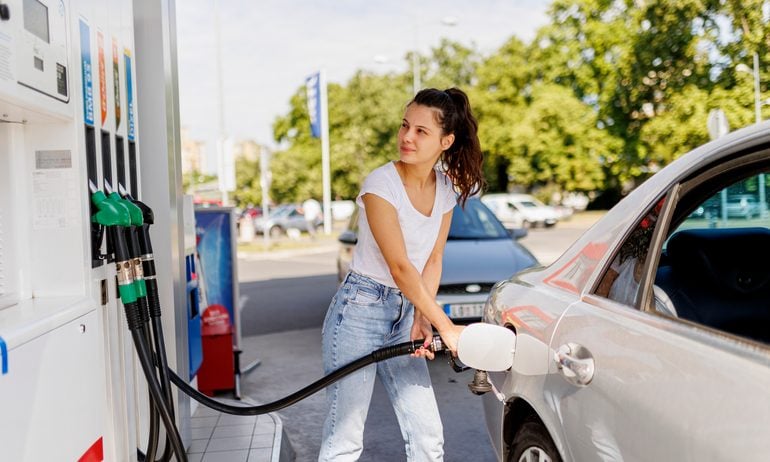Gas Prices Level Out Ahead of Independence Day
With oil prices starting to drop after spiking over Mideast tensions, holiday drivers are catching a break.

Many, or all, of the products featured on this page are from our advertising partners who compensate us when you take certain actions on our website or click to take an action on their website. However, this does not influence our evaluations. Our opinions are our own. Here is a list of our partners and here's how we make money.
Updated on June 27.
The average regular gas price in the U.S. as of June 27 is $3.207 per gallon, according to AAA, down from $3.447 a year ago, but up slightly since last month.
Gas prices have dipped a bit after a mild climb in recent weeks, and as of June 27 remain a few cents higher than a month ago. Two weeks ago gas prices were below $3 in 28 states — as of June 27, there were just 14 states at that level. Still, the national average hovers near some of the lowest levels since 2021.
All in all, that’s good news for summer road trippers. Heading into the Independence Day holiday period between June 28 to July 6, some 61.6 million people will travel at least 50 miles or more by car, according to AAA. Some 1.3 million more travelers will travel by car compared to last year.
Why are oil prices going up?
There’s still much uncertainty surrounding the conflict between Israel and Iran, as well as its impacts on oil prices. In recent weeks, oil commodity prices rose, but as of but as of Friday, price levels were dropping in the face of weak demand. If conflict reignites, commodity prices will likely increase worldwide and, in turn, could increase consumer gas prices once existing inventories are depleted. Much depends on either government’s next moves.
JP Morgan Chase analysts warn that if there is a full-scale conflict, it could block the Strait of Hormuz — an oil corridor for about 20% of global crude oil. If it were blocked, it could send prices soaring to $120 or $130 per barrel, as it did following Russia’s invasion of Ukraine. So far the strait remains open and oil prices remain below high price levels seen earlier this year.
Gas price inflation, explained
It wasn’t that long ago that gas prices were soaring: Prices surged in 2021 and 2022, largely due to two economic disruptions: pandemic-related supply shocks and then Russia’s invasion of Ukraine. The combination of the two hit energy markets hard and prices never recovered to pre-pandemic levels.
Here’s what happened:
In 2019, before the pandemic, the average per-gallon price of regular gas was $2.601, according to EIA data.
Following Russia’s invasion of Ukraine, the national average increased before peaking at $5.016 per gallon on June 14, 2022, according to AAA.
Since then, gas prices have retreated, but they haven’t returned to pre-pandemic levels. Today, gas prices are about 9% higher than they were six years ago.
Why gas prices remain higher than they used to be
At this time of year, seasonal factors play a considerable role in raising gas prices. A scheduled switch to summer-blend gasoline temporarily elevates prices through the warm months. Inflation, supply-chain disruptions and gas tax hikes can factor into higher prices, as well. But in the end, elevated oil prices are the main culprit.
The cost of oil typically represents more than half of the cost of a gallon of gasoline, according to the U.S. Energy Information Administration (EIA). So, a major reason gas prices have remained so high is that, until recently, oil prices were higher than they were before the pandemic hit in 2020 and Russia invaded Ukraine in 2022. That’s based on the average monthly price of West Texas Intermediate crude, which is used as the benchmark for oil prices in North America.
Keep in mind that gas prices at the pump rarely reflect that day’s market conditions. Instead, they represent costs incurred weeks, even months before. That lag makes prices slower to rise and fall than news headlines might suggest. And while spot shortages, refinery production shortages or blending issues can drive up gas prices locally, big nationwide swings in gas prices are almost always due to the price of crude oil.
Gas prices were sliding for months
Gas prices began to drop steadily in the fall, and stayed relatively low through the winter. Seasonally, the direction of prices was expected. During the cooler months, consumer demand is lower and the blend of gasoline is cheaper to make. That tends to hold down prices until spring.
But price levels over the winter were the lowest we’d seen in awhile. In December, the national average nearly touched $3 per gallon for the first time since May 2021, according to AAA. (It’s worth noting that, in a competing analysis, GasBuddy says the national average was $2.89 in December.)
Between May 1 and Sept. 15, gas refineries switch from winter-blend to summer-blend gasoline, which is more expensive to make. That's one reason gas prices tend to increase in the spring and summer and decrease in the fall and winter. Summer-blend gasoline is formulated to limit emissions during the warmer months when gas can evaporate more easily.
Even as prices started to tick up over the past month, they remained much lower than a year ago. Here’s how gas prices compare today:
As of June 27, the average regular gas price in the U.S. is $3.207 per gallon, according to AAA, which tracks gas prices.
The price is up from $3.174 per gallon a month ago.
A year ago, the price was $3.503 per gallon.
At the moment, recent price fluctuations are short-term trends happening within the larger picture of elevated gas prices. But experts said they could continue in 2025 — and the impact of President Donald Trump’s tariffs appears to make that even more likely. That’s because oil prices, though still higher than they were before the pandemic, have been trending down. A week after Trump’s tariff announcements, WTI crude prices were down 27% compared to July and 50% from their peak in 2022.
Average gas price per state
The average gas price per state varies widely, with the most expensive state typically costing about $2 more per gallon of regular than the least expensive state.
» MORE: Why is diesel so expensive?

